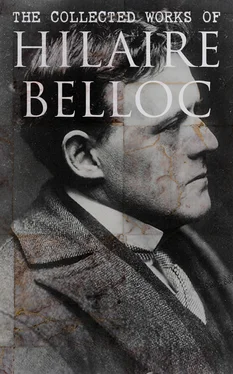The Marque made all the difference. It compelled the fifth column to take its roundabout road, and the fourth, detained by the delay of the fifth, was held, as we shall see in what follows, for a whole day at one of the crossings of the river.
The little stream has a deep and muddy bottom, and the fields upon its banks are occasionally marshy. This feature has been exaggerated, as have the other features I have mentioned, in order to explain or excuse the defeat, but, at any rate, it prevented the use of crossing places other than bridges. The Marque has no true fords, and there is no taking an army across it, narrow as it is, save by the few bridges which then existed. These bridges I have marked upon the sketch.
So far as the terrain is concerned, then, what we have to consider is country, flat, but containing low defensive positions, largely cut up, especially between the Scheldt and Roubaix, by hedges and walls, though more open elsewhere, and particularly open towards the north: a serious obstacle to the advance of one body in the shape of the River Lys; and another obstacle, irritating rather than formidable in character, but sufficient both by its course and its marshy soil to complicate the advance, namely, the little River Marque.
* * * * *
As to the weather, it was misty but fine. The nights in bivouac were passed without too much discomfort, and the only physical condition which oppressed portions of the allied army consisted in the error of its commanders, and proceeded from fatigue.
Table of Contents
At about ten o’clock in the morning of Friday the 16th of May, Clerfayt, in his positions right up north beyond the Lys—positions which lay at and in front of the town of Thielt, with outposts well to the south and west of that town—received the orders of the Emperor.
These orders were what we know them to be: he was to march southward and westward and strike the Lys at Wervicq. He was to arrive at that point at or before nightfall, for in the very first hours of the morrow, Saturday, and coincidently with the beginning of the advance of the five columns from their southern posts, he was to cross the Lys and to proceed to join hands with those columns in the following forenoon, when the heads of them would have reached the neighbourhood of Tourcoing and Mouveaux.
Bussche, with the first column, his 4000 Hanoverians, had no task during that day but to proceed the mile and a half which separated Warcoing from the little village of St. Leger, and, with the head of his column in that village, prepare to pass the night and be ready to march forward long before dawn the next day.
Field-Marshal Otto, with the second column, was similarly and leisurely occupied marshalling his 10,000 Austrians and his contingent of British cavalry, so that the head of his column was at Bailleul ready also to advance with the early, dark, small hours of the ensuing morning.
The Duke of York, with his third column of similar numbers, or somewhat less, was performing a precisely similar task, and ordering his men so that the head of that column should reach Templeuve by evening and be ready to march at the same moment as the others did, shortly after midnight.
All these three, then, were absolutely ready, fresh from fatigue and in good order, upon that Friday evening at their appointed posts.
It is here necessary, as we are chiefly concerned with the British forces, to detail the composition of this third column which the Duke of York commanded.
It consisted of twelve battalions and ten squadrons, with a further reserve of sixteen British squadrons under General Erskine, which cavalry lay somewhat south of Templeuve, but ready to follow up the advance when it should begin. It was made of two portions, about equal in numbers, British and foreign. The foreign half was composed of four squadrons of Austrian Hussars and seven battalions of infantry, two Hessian and five Austrian. The British half was composed of a Brigade of Guards counting four battalions, with portions of the 14th, 37th, and 53rd Foot, while the British cavalry accompanying it (apart from the squadrons under Erskine) were six squadrons drawn from the 7th, 15th, and 16th Light Dragoons. It is to the credit of the young commander 4that this third column was the best organised, the most prompt, and, as the event proved, the most successful during the advance and the most tenacious in the subsequent defeat.
The fourth column, under Kinsky, about 11,000 strong, was also ready on that Friday, the 16th of May, concentrated at its point of departure, Froidmont, and ready to move at the same moment as all the others, shortly after midnight. But unlike the other three commanders upon his right, Kinsky was unfortunately handicapped by the position of the fifth column, that great body of 18,000 to 20,000 men, under the Arch-Duke Charles, which lay at St. Amand, which was to advance next day parallel with Kinsky and upon his left, and which it was his duty to keep in touch with, and to link up with the Duke of York’s upon the other side. He was handicapped, I say, by the situation of the fifth column, under the Arch-Duke Charles, the heavy strain already imposed upon which, and the accumulating difficulties it was about to encounter, largely determining the unfortunate issue of the battle.
Kinsky got news on that Friday from the Arch-Duke at St. Amand that it was hardly possible for his great body of men to reach the appointed post of Pont-à-Marcq at the arranged hour of daybreak the next morning. I have already suggested that this delay cannot only have been due to the very long march which had been imposed upon the Arch-Duke’s command when it had been hurriedly summoned up from the south to St. Amand, forty-eight hours before. It must also have been due to the fact that not all its units reached St. Amand by the evening of Thursday the 15th. It seemed certain that there must have been stragglers or bad delays on the morning of the 16th, for it was not until long after nightfall—indeed not until ten o’clock in the evening—of Friday the 16th that the Arch-Duke was able to set out from St. Amand and take the Pont-à-Marcq road. This unfortunate body, therefore, the fifth column, which had all the hardest work before it, which had but one road by which to march (although it was double any of the others in size), was compelled, after the terrible fatigue of the preceding days, to push forward sixteen miles through the night in a vain attempt to reach Pont-à-Marcq, not indeed by daybreak, for that was obviously impossible, but as soon after as haste and anxiety could command. Kinsky was tied to Froidmont and unable to move forward until that fifth column upon his left was at least approaching its goal. For he had Bonnaud’s 20,000 Frenchmen at Sainghin right in front of him, and further, if he had moved, his left flank would have been exposed, and, what is more, he would have failed in his purpose, which was to link up the Arch-Duke on one side with the Duke of York upon the other.
This first mishap, then, must be carefully noted as one prime lack of synchrony in the origins of the combined movement, and a first clear cause of the misfortune that was to attend the whole affair. The delay of the fifth column was the chief cause of the disaster.
Meanwhile, another failure to synchronise, and that a most grave one, was taking place miles away in the north with Clerfayt’s command beyond the Lys.
It is self-evident that where one isolated and distant body is being asked to co-operate with comrades who are in touch with the commander-in-chief, and with each other, the exact observation of orders on the part of that isolated body is of supreme importance to the success of the combination. They , all lying in much the same region and able to receive and transmit orders with rapidity, may correct an error before it has developed evil consequences. But the isolated commander co-operating from a distance, and receiving orders from headquarters only after a long delay, is under no such advantage. Thus the tardiness of the fifth column was, as we have seen, communicated to the fourth, and the third, second, and first, all in one line, could or should have easily appreciated the general situation along the Scheldt. But the sixth body, under Clerfayt, which formed the keystone of the whole plan, and without whose exact co-operation that plan must necessarily fail, enjoyed no such advantage, and, if it indulged in the luxuries of delay or misdirection, could not have its errors corrected in useful time. A despatch, to reach Clerfayt from headquarters and from the five columns that were advancing northward from the valley of the Scheldt, must make a circuit round eastward to the back of Courtrai, and it was a matter of nearly half a day to convey information from the Emperor or his neighbouring subordinates in the region of Tournai to this sixth corps which lay north of the Lys.
Читать дальше












